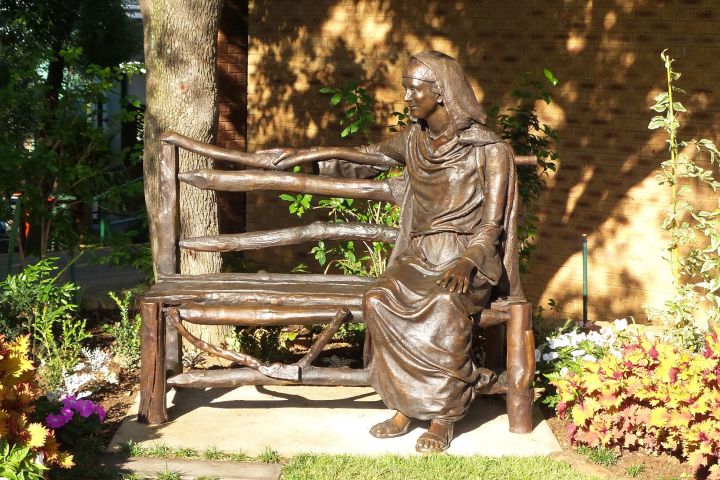
Ursuline Catholic Ethos
The late Pope John Paul II stated: “The reason for the existence of the Catholic School, is the quality of religious instruction integrated into the life of the pupils.” The Catholic Christian ethos of Brescia House Ursuline Convent School depends basically and entirely on its foundation of faith in Christ, his teaching and salvation.
Ursuline Catholic Ethos
Our Patroness Saint Angela Merici
Angela Merici was born during the Renaissance (about 1474) in Italy. She was a woman of prayer, who was inspired by Christ's love, generously open to other people's needs, and sensitive to the critical social and spiritual needs of her time. She and her first companions dedicated their lives to God and his work. Brescia House School was founded by Ursuline Sisters, who have poured their resources and skills into developing the school, and continue to do so for the benefit of all Ursuline Sisters and all laypeople around the world who share the conviction that Angela Merici's educational vision is a living and proven model that satisfies the deepest needs of our time. With Angela's writings, we are left with a deep heritage of Christian principles of education that have been developed and enriched in Ursuline schools worldwide for the past four centuries and continue to be the living legacy of this rich educational network. Unity comes about through the quality of our network of colleagues, in our manner of relating to one another, and in maintaining occasions for rejoicing and celebrating together. At the centre of true unity lies prayer and worship. We emphasize that this unity and harmony does not exist solely for our benefit; instead, it creates the strength to reach out to all those who need our help and care, including the poor and needy in any way, including everyone, with a broad understanding of the common good.
The Story of Saint Ursula
Angela chose Ursula as the patron saint of her group of dedicated women when she established it in 1535. Ursula, a young woman who loved God more than death, presented her sisters as a model and a challenge for faithful and unstinting service to God and his people. Thus, the "Company of St Ursula" later "The Ursulines" set out on their long pilgrimage of love through history. Who was this young woman so inspired, Angela, and whose name has been made so widely known throughout the world by thousands upon thousands of Ursulines, their collaborators, and their pupils? The full historical facts about Ursula have been lost in the mists of time and history. However, the legend of Princess Ursula and her eleven thousand companions, thought to be a product of popular devotion and lively imagination, contains a kernel of truth. Archaeologists and historians are satisfied that a group of virgins as far back as the third century were indeed martyred at Cologne, Germany, thus offering their radiant witness of faith in and love of Christ. A basilica was certainly built in their honour at an early date on the very spot where the church of St Ursula stands today. According to legend, Ursula, a beautiful Christian British princess betrothed to a pagan Frankish prince, decided to make a pilgrimage to Rome before her marriage. She arrived in Rome with her attendants, where she met the Pope, who decided to accompany her on her journey. Sailing down the Rhine, Ursula's boats stopped at Mainz, where she was met by Aetherius, whom the Bishop of Mainz baptized. As Ursula and her companions arrived at Cologne, they were killed by the Huns, a tribe of fierce warriors who had invaded the area. According to all versions of the legend, Ursula was accompanied by 11 000 virgin companions, all of whom were martyred with her. In the present day, historians believe that this number is due to an early error with a stone found in the church of St. Ursula engraved in Latin with the words "eleven virgin martyrs." However, as we look back on the year 11 000 from the beginning of the third millennium, it is not difficult to see the countless numbers of Ursuline sisters, their collaborators, and the children they have educated who, down through the centuries since St Angela Merici founded her Company, have claimed St Ursula of Cologne as their model and helper.
The Catholic Institute of Education
In Brescia House School, the curriculum is based on the CORD and Lifebound syllabi and the Catholic Institute of Education's guidelines. Three lessons per week are given to each grade based on the liturgical calendar. Brescia House School also offers a programme that prepares students in Grade 4 for the Sacraments of Reconciliation and Holy Communion and in Grade 10 for the Sacrament of Confirmation.
Participation in the Mass
The celebration of Holy Mass is central to the faith life of the school community, and pupils attend Mass weekly in the primary school, monthly in the secondary school, and on feast days and special holy days.
Brescia House School also encourages full participation in Parish events, such as the Stations of the Cross, Easter and Advent services, and membership in Alpha, the Youth Lifeteen group, and involvement in parish outreach projects.
Dedication of time to Prayer and Worship
Prayer is encouraged from grade R to grade 12, at the beginning and end of the school day, during daily religion lessons, with grace at mealtimes, at the Angelus noon bell, and to the Guardian Angels and Mary, the Mother of Christ.
Annual Retreats for Prayer and Reflection
Taking part in annual retreats for Grades 4 - 12 provides the girls time away from school commitments and allows them to reflect, reflect, praise, and worship in a different environment.